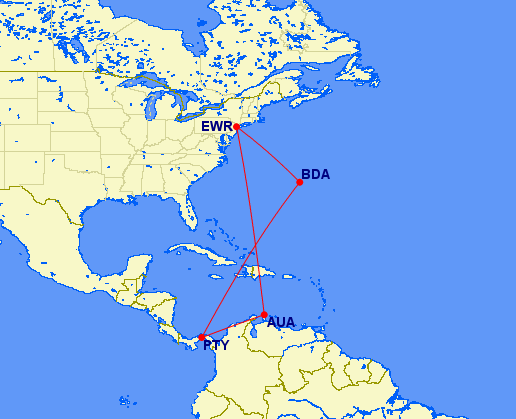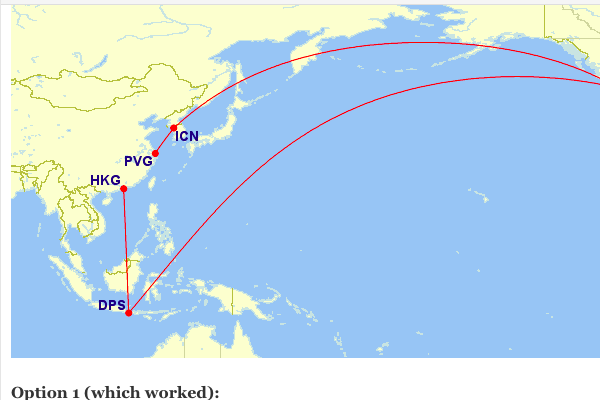When using United miles, which stop is the stopover and which stop is the destination? And how do you know if the stopover is allowed?
This is combining two concepts from two advanced posts: The Secrets of Award Pricing, the most powerful zones; & United’s Real Routing rules and how to get around them.
You see, the key to what makes a stopover or a destination is simply the price.
“Wait… shouldn’t the destination determine the price, not the price determine the destination?”
Should? I don’t know. But the reality is that when you combine two regions by making one a stopover and the other a destination, it doesn’t always price things logically. So for example, USA to Europe (stop), continues to Asia (stops again), and returns home. Most people assume that because Europe is the first stop that it means that Europe is the stopover and Asia is the destination.
But that logic doesn’t work if you flip it. USA to Asia (stop), continues to Europe (stops again), and returns home. Asia is not now the stopover, Europe is still the stopover on the way home. But why?
Because no matter what way you mix the two, SE Asia is the more powerful zone. Meaning? Meaning that the price will always be 65,000 miles (in economy). See a roundtrip to just SE Asia would be 65,000 miles and a roundtrip just to Europe would be 60,000. But when you combine the two, every single time it will price out as 65,000 miles – a Southeast Asia award.
Again, SE Asia is the more powerful zone of the two and therefore it is always the destination. You are allowed one stopover and it doesn’t matter if it’s on the way there or back.
This may seem like semantics, as who cares which way the stopover is?
Well, when you get into applying a stopover on a (semi) oneway award using… tricks… and you’re using your new found knowledge to take advantage of great prices, you’ll understand. Hopefully.
Otherwise, it doesn’t matter too much which is which. After all you can apply open-jaws to both the stopover and the destination.
However, if you are using an open-jaw to return to a different region you need to know from which region you’ll be returning. In other words, if you open-jaw so that you return to the Caribbean instead of the US, you will need to know whether or not you’re returning from Europe or SE Asia. After all there is a price difference.
Understanding which stop is the destination (which is the more “powerful” region), means that when I’m looking to open-jaw somewhere else, I can look at the award chart and know what price I’ll be charged.
For example, if I go from North America to Australia and Fiji (Oceania region) it would charge me 70,000 miles roundtrip. Why when a ticket to Sydney, Australia should be 80,000 miles roundtrip? Because Oceania is a more powerful zone when starting from the US. So this means that by adding a flight to Fiji on your trip, you save miles. Yes, you would save miles by going to Fiji as well as Sydney.
Ok, but let’s say you want to end in Hawaii. (It doesn’t matter why let’s say you’ll use Avios to get home, or you have a free one-way set up with AA miles, or you’re simply trying to lower the price and hopefully the agent will let you layover in your home town). In other words, USA to Fiji (destination), to Sydney (stopover), to Hawaii (end).
By using one of your open-jaws to return home to a different place, you will end up paying a different price. But how much will you pay for the Hawaii portion? Oceania to Hawaii is 25,000 miles (in economy) and Australia to Hawaii is 35,000 miles. Which one will it choose?
Of course it will price the lower 25,000 miles for that half of the trip. Why? Because Oceania (Fiji) was made our destination. Thus the trip should cost about 60,000 miles (35k+25k) to see Australia, Fiji and Hawaii. Much less than the normal 80,000 miles to see only Australia. Then again… this doesn’t get you home it gets you to Hawaii.
Never the less this same concept applies across the board.
Without going into too much detail, things get a little confusing when you are starting from different regions. The post, Secrets of Award Pricing – The Most Powerful Zones, it only lists the most powerful regions starting from the US. It’s different even when starting in Hawaii. So when you are open-jawing to a different region the price may throw you off. It might not let you do the tricks you thought you’d do because you falsely assumed that one region would be the destination when it isn’t.
On which routes are stopovers allowed?
- It has to be a roundtrip .
- You have to change regions. Hawaii would count as a region change but Canada would not.
- The zones have to be combinable. As explained in the very advanced post regarding United’s Routing Rules, some zones can’t be combined. For example you can no longer stopover in South America on your way to Africa. Just can’t. Not because of stopovers but because the two zones can’t be on the same award ticket period. Well…. on the same half of a roundtrip ticket.
Well then, what city pairs are allowed?
It doesn’t matter. Think zones. Seriously, people have a hard time grasping the flexibility of these awards. You can stopover in Aruba, layover in Panama, all on your way to Bermuda! That’s not a joke! Although it’s almost a punch line.”Want to know how loose United’s routing rules are?” “Let me guess… my mom?” “No! You can stopover in Aruba on your way to Bermuda.” It doesn’t make any sense as Bermuda is in the Atlantic… but it’s considered the Caribbean in terms of regions and therefore it’s possible to combine the two.
For more about that kind of trip, read How to Book The Caribbean Hopper with United Miles. But the other more advanced posts talk about other routes, some of which are way more surprising than that. And if you’re ready to learn more about this, read about advanced routing rules for United Awards.
However, there are many problems with the Multiple Destination tool on United. I’ll have a post in a week on the problems and glitches of United.com, but until then, the important thing to know is that it doesn’t always tell the truth. Especially when using the Multiple Destination tool, it sometimes shows less availability than there actually is and gives an error message.
I know this is somewhat complex so please let me know what questions you have or what clarifications you need.




![The [Only] United MileagePlus Award Chart](https://travelisfree.com/wp-content/uploads/2019/04/United-MileagePlus-United-Airlines-Award-Chart-120x86.jpg)


Excellent post, and I keep learning a lot by reading your work. What I’m needing to understand better is what you develop in your last paragraph. I’m good with the Multiple Destination tool, but not so good yet at understanding what is really possible when the Multiple Destination tool says no. I’m looking at a Pacific redemption for next summer (as soon as I can firm up which dates I’ll be free to travel), and find the examples useful.
awesome post man, appreciate your writing even though the topic takes awhile to sink in but I m still confused. anyways I have a booking with united that touches on this topic, could you help look at this itinerary if its legal to book and falls into the rules. thanks
lax-icn-hkg(layover 24hr)
hkg-bkk(stopover)
bkk-sgn(destination)
sgn-tpe-lax(home)
can I have a stopover in the same region?
can I squeeze an open in there somewhere ?
Appreciate your help, Thanks
You’re taking the lead from Milvalue when it comes to hacking United awards. Nice work!
More like running away with it.. from every blogger out there!
sorry missing word from the above question. the question was
to squeeze an open Jaw into the itinerary ?
cant wait to read your next post on the multiple destination tool I hate that thing. Half the time I get an error coming out of HNL, maybe more and I don’t really feel like calling just to see if its possible.
This is very informative and useful information. Thank you!
@ DaveS – Well, understanding ho to work with error is kind of the least important part as if you know the concepts, you can just call. However, the post next week on the topic should help.
@ choi – Stopover goes wherever you like. And yes, you can add an open-jaw to any of those stops. 😉 So for example you open-jaw from Saigon to Hanoi and train or something up the coast. Anything you want really.
@ Julian – Thanks Julian. I’m glad you enjoy it!
@ Royce – Yes! blah, Hawaii (and many other pacific places) gives me the error more than anywhere else. I’ve said this before and someone “corrected” me about it. But I swear United.com has cursed Hawaii on their award search results! (and with good reason if you’ve noticed the award chart).
@ Miles – De nada. Hope you indeed get to use it… and that’s for commenting.
I found an oddity doing dummy searches – RT to SE Asia is, as you say, 65K miles. RT to Africa is 80K miles. But I had an award to SE Asia with a stopover in Africa price out at 65K miles! EWR-LIS-RAK(stopover)-GVA-BKK(destination)-LHR-EWR routing.
Well it sounds like you’re getting familiar with the stopover searches. 😉
I’d encourage you to read this post to find out more. http://travelisfree.com/2013/06/10/secrets-of-award-pricing-engines/
Huge fan of your website and realize this post is old! I’m planning to travel from London to Brazil with a stopover in the US on my way back to Europe – my actual booked routing is LON-RIO;SAO (open jaw)-EWR (stopover)-LON. When I go to upgrade my reservation with miles, it’s pricing the return journey as 45k miles (25k Southern South America-US; 20k US-Europe) instead of the 35k it would cost to go from S. South America-Europe. The first United agent I spoke with about it agreed it should be 35k, but after a few recent HUCA’s agents are going with the 45k. Based on your experience, what should it be and is there anything on the United site that supports it? Thanks!